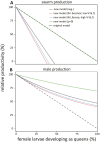Toward greater realism in inclusive fitness models: the case of caste fate conflict in insect societies
- PMID: 38818418
- PMCID: PMC11134464
- DOI: 10.1093/evlett/qrad068
Toward greater realism in inclusive fitness models: the case of caste fate conflict in insect societies
Abstract
In the field of social evolution, inclusive fitness theory has been successful in making a wide range of qualitative predictions on expected patterns of cooperation and conflict. Nevertheless, outside of sex ratio theory, inclusive fitness models that make accurate quantitative predictions remain relatively rare. Past models dealing with caste fate conflict in insect societies, for example, successfully predicted that if female larvae can control their own caste fate, an excess should opt to selfishly develop as queens. Available models, however, were unable to accurately predict levels of queen production observed in Melipona bees-a genus of stingless bees where caste is self-determined-as empirically observed levels of queen production are approximately two times lower than the theoretically predicted ones. Here, we show that this discrepancy can be resolved by explicitly deriving the colony-level cost of queen overproduction from a dynamic model of colony growth, requiring the incorporation of parameters of colony growth and demography, such as the per-capita rate at which new brood cells are built and provisioned, the percentage of the queen's eggs that are female, costs linked with worker reproduction and worker mortality. Our revised model predicts queen overproduction to more severely impact colony productivity, resulting in an evolutionarily stable strategy that is approximately half that of the original model, and is shown to accurately predict actual levels of queen overproduction observed in different Melipona species. Altogether, this shows how inclusive fitness models can provide accurate quantitative predictions, provided that costs and benefits are modeled in sufficient detail and are measured precisely.
Keywords: caste fate conflict; inclusive fitness theory; social evolution; stingless bees.
© The Author(s) 2024. Published by Oxford University Press on behalf of The Society for the Study of Evolution (SSE) and European Society for Evolutionary Biology (ESEN).
Figures



Similar articles
-
Caste fate conflict in swarm-founding social hymenoptera: an inclusive fitness analysis.J Evol Biol. 2003 Jul;16(4):647-58. doi: 10.1046/j.1420-9101.2003.00574.x. J Evol Biol. 2003. PMID: 14632228
-
Tragedy of the commons in Melipona bees revisited.Biol Lett. 2022 Jan;18(1):20210498. doi: 10.1098/rsbl.2021.0498. Epub 2022 Jan 26. Biol Lett. 2022. PMID: 35078331 Free PMC article.
-
Towards greater realism in inclusive fitness models: the case of worker reproduction in insect societies.Biol Lett. 2013 Oct 16;9(6):20130334. doi: 10.1098/rsbl.2013.0334. Print 2013. Biol Lett. 2013. PMID: 24132088 Free PMC article.
-
Conflict and major transitions - why we need true queens.Curr Opin Insect Sci. 2019 Aug;34:73-79. doi: 10.1016/j.cois.2019.03.009. Epub 2019 Apr 3. Curr Opin Insect Sci. 2019. PMID: 31247422 Review.
-
Conflict resolution in insect societies.Annu Rev Entomol. 2006;51:581-608. doi: 10.1146/annurev.ento.51.110104.151003. Annu Rev Entomol. 2006. PMID: 16332224 Review.
Cited by
-
Innovation in ant larval feeding facilitated queen-worker divergence and social complexity.Proc Natl Acad Sci U S A. 2025 Mar 4;122(9):e2413742122. doi: 10.1073/pnas.2413742122. Epub 2025 Feb 25. Proc Natl Acad Sci U S A. 2025. PMID: 39999174 Free PMC article.
-
Intragenomic conflict associated with extreme phenotypic plasticity in queen-worker caste determination in honey bees (Apis mellifera).Genome Biol. 2025 Jun 18;26(1):171. doi: 10.1186/s13059-025-03628-0. Genome Biol. 2025. PMID: 40533789 Free PMC article.
References
-
- Abbot, P., Abe, J., Alcock, J., Alizon, S., Alpedrinha, J. A. C., Andersson, M., Andre, J. -B., van Baalen, M., Balloux, F., Balshine, S., Barton, N., Beukeboom, L. W., Biernaskie, J. M., Bilde, T., Borgia, G., Breed, M., Brown, S., Bshary, R., Buckling, A., … Zink, A. (2011). Inclusive fitness theory and eusociality. Nature, 471(7339), E1–E4; author reply E9. 10.1038/nature09831 - DOI - PMC - PubMed
-
- Alves, D. A., Menezes, C., Imperatriz-Fonseca, V. L., & Wenseleers, T. (2011). First discovery of a rare polygyne colony in the stingless bee Melipona quadrifasciata (Apidae, Meliponini). Apidologie, 42(2), 211–213. 10.1051/apido/2010053 - DOI
-
- Bego, L. R. (1983). On some aspects of bionomics in Melipona bicolor bicolor Lepeletier (Hymenoptera, Apidae, Meliponinae). Revista Brasileira de Entomologia, 27, 211–224.
-
- Bego, L. R. (1989). Behavioral interctions among queens of the polygynic stingless bee Melipona bicolor bicolor Lepeletier (Hymenoptera, Apidae). Brazilian Journal of Medical Biological Research, 22, 587–596.
Associated data
LinkOut - more resources
Full Text Sources
Miscellaneous

